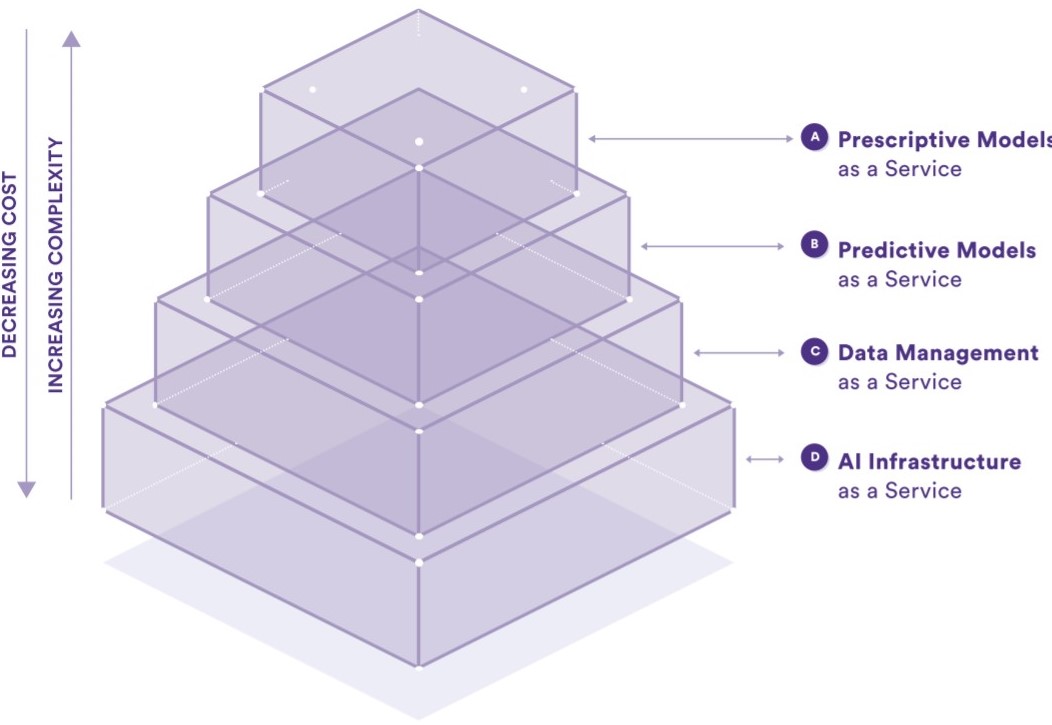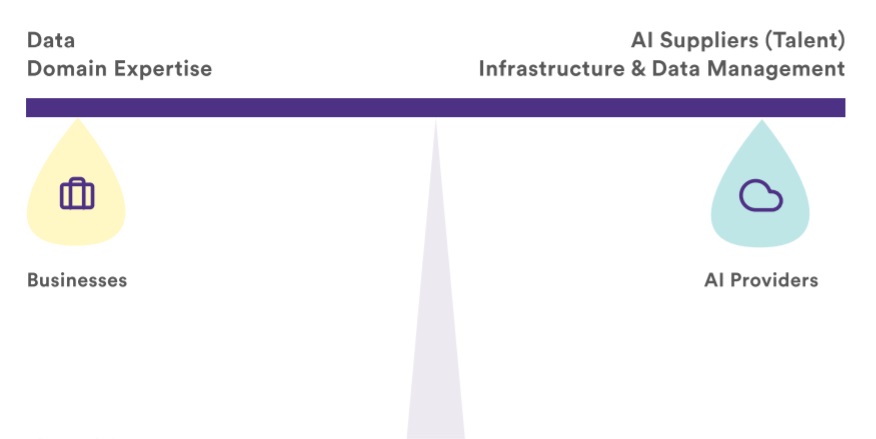Build or Buy? 4 steps to adopt AI into your business strategy

In the final quarter of the full-time MBA program in the University of Washington’s Foster School of Business, three MBA students crafted an independent research study in an attempt to demystify the understanding of artificial intelligence. Shobhit Gupta (MBA 2020), Abhro Pal (MBA 2020), and Alexis Goodrich (MBA 2020), used their extensive background in innovation management to create a paper titled “AI: Accessibility, Adoption, and Management.” Their aim is to provide thought leadership to top executives at Fortune 500 companies who are building a multi-year roadmap to adopt Artificial Intelligence.
In three months, the students interviewed 10 key stakeholders from AI startups, AI research, AI venture capital firms, and Pacific Northwest technology giants to understand how they foresee using AI adoption to increase business profitability. The trio gained insights from leaders at Madrona Venture Group, Flying Fish Partners, Paul G Allen School of Computer Science, Microsoft, Amazon (AWS), and more before looking to widely share the results.
As an addendum to the complete paper and research (linked below), the students shared with the Foster School why they were motivated to pursue business research in AI and what can be learned from their conclusions.
What inspired you to pursue business research in Artificial Intelligence?
In our final quarter of study in the Foster MBA program we asked ourselves: “Why do AWS, Azure, and Google Cloud launch new cloud and AI services each year when they already have, in some cases, more than 200 current offerings? Both AWS and Azure have 200+ services!”. Each of us had gained additional experience in AI and Cloud working as product managers during our MBA summer internships. Our experience helping customers adopt AI in business use cases was not enough to answer that question. What we needed was a structured independent study to truly understand how AI can be applied to create business value for decades to come. If AI is a blue ocean market opportunity, we wanted to nail down the “Why, How, and What?”
How did you start wrapping your head around the topic?

Abhro Pal
We went back to how major technology innovations impacted businesses in the past. For example, the maritime navigation systems transformed the mercantile system due to reduced transportation costs in the 13th century. In the 19th century, steam engines enabled the production of standardized designs at scale. A trend emerged that innovation precedes business needs as highlighted by Clayton Christenson in “Innovator’s Dilemma.” Businesses need to learn how to leverage innovations to create value and capitalize it. In the 20th century, Henry Ford famously said “If I had asked people what they wanted, they would have said faster horses.” Now, we understood that AI is part of the current era of innovation and shares similarities with innovations of the past. It is a big bang and we need astute business strategy to guide AI towards creating profitability. In simple terms, we believe each firm is pushing the power of digital business as if attempting to transition from a horse cart to a race car. While the technology companies are experimenting to build the next Ford, businesses are racing to define where they want to go with it.
What are the business leaders talking about AI and what are the barriers to adopting AI?
While talking to business leaders, it became clear that the hardest software services to understand today are Artificial Intelligence as a Service, or AIaaS. The reason springs from the high cost of adoption, the complexity in articulating the business value of AI, and the limited in-house experts to understand AI. Like Software as a Service, or SaaS, the AIaaS is a cloud-first approach for businesses to adopt AI with minimal internal teams to support. For example, a website can integrate AI chatbot functionality to provide robotic customer service without writing a line of code. But unlike SaaS, the AIaaS needs continuous feedback and data from the conventional business to operate. That need opens a whole box of business model opportunities.
Despite the enthusiasm around AI, there are two key challenges that Chief Information Officers (CIOs) need to address before they can create value from the emergence of AI. First, CIOs need to address the build versus buy dilemma (i.e. which solutions should be built in-house and which ones should be bought off the shelf and/or outsourced?). The market is currently overwhelmed with AI products and services. In addition to cloud-based AI services that are being launched rapidly, there are AI startups providing solutions customized to industry needs. Second, once the build vs buy decision has been made, CIOs need to devise an implementation strategy. Given the limited AI expertise coupled with the complexity in articulating clear business in adopting AI, this is a hard question to answer.
What are the different building blocks of creating an AI powered software application?
The following are four building blocks that a business needs to build AI software applications:
- Cloud Infrastructure (hardware and platform services to run your software) which can be procured from a cloud provider such as AWS, Azure, GCP or a private server.
- Training Data (such as transactions, text, images, voice etc.) which serves as the eyes and ears of a machine to understand external stimuli.
- Predictive Models (Algorithms that provide recommendation for next best action and learn from the feedback of human experts).
- Prescriptive Models (Algorithms and Control Systems that automate decision-making and learn from the results).
How can a business build, buy, or do both in relation to these AI powered applications?
CIOs and business leaders face a decision—whether to hire a team of AI experts in-house to build AI from the bottom-up, buy off the shelf AI from AIaaS providers, or pursue a hybrid approach that prioritizes future competitive advantages. The key decision metrics to solve the build vs buy decision is similar to the conventional outsourcing model: keep strategic initiatives in-house to ensure patent and IP protection, enhance speed and accuracy of execution, and avoid the high costs of customizing AI as a Service to suit their needs.
The decision to use AI as a Service is easy for commodity use cases such as customer service, human resources, and marketing as they do not possess any competitive advantage for the core business. But for data sensitive use cases which define the competitive edge of a company, the decision is harder. For example, AI to optimize delivery routes and timing for a logistics company such as FedEx based on both real-time and historic data leads to FedEx outperforming DHL in terms of reduced cost of doing business and faster delivery. Hence, FedEx sees the value of building AI in-house while keeping their customer service outsourced to AIaaS providers. Similarly, Dow Chemicals would like to build AI for energy management in-house since Dow can optimize raw materials costs for chemical plants and build a competitive advantage over BASF.
That said, the first step towards implementing AI is not to hire a team of experts. The first step is to identify a business use case and use out-of-the-box services from AIaaS provider to create a quick prototype. If a business does not have an in-house software team, the consulting companies such as Deloitte and Accenture can help build a prototype. In conclusion, the only way for a business to learn the value of AI in a use case is to apply AI in a controlled sandbox environment and experiment with various resources. The process of implementing AI cannot be a long-term decision before conducting extensive experimentation.
How should businesses think about engaging with AI as a service supplier?
In the short term, a partnership with leading AI providers helps to decrease the cost of adoption and increase the quality of products.
 We have recognized 4 key elements of power balance between a buyer and seller of AI service. We have concluded that the power balance is horizontal today leading to symbiotic partnership. Thus, a partnership to build AI together is a win-win scenario for technology companies and conventional businesses since the tech companies provide the AI talent and tools at scale while the businesses provide access to industry experts and proprietary data.
We have recognized 4 key elements of power balance between a buyer and seller of AI service. We have concluded that the power balance is horizontal today leading to symbiotic partnership. Thus, a partnership to build AI together is a win-win scenario for technology companies and conventional businesses since the tech companies provide the AI talent and tools at scale while the businesses provide access to industry experts and proprietary data.
Click here to read the full report: “AI: Accessibility, Adoption, and Management.”
Guest post by Shobhit Gupta (MBA 2020), Abhro Pal (MBA 2020), and Alexis Goodrich (MBA 2020).



